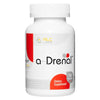Energy is the currency of the body, and everything you do requires your body to produce energy for you. If you are feeling fatigued, or if you are running out of energy, you should be concerned about your underlying health.
Fatigue is a very important sign that your body is not coping with your energy requirements. When you are fatigued, your organs may not be producing or receiving the energy they need to function efficiently. If your organs are under pressure, your health will suffer.
If you understand the way your body produces energy, you can take the necessary steps and precautions to ensure your body has enough energy to function, and that you have enough energy to enjoy life.
There are
three main processes that your body can use to make energy. These processes differ in the time it takes to produce energy, the amount of energy that can be produced, and the fuel sources required for each type of process.
The body can produce energy using:
- The ATP Phosphocreatine process
- Anaerobic Glycolysis
- Aerobic Phosphorylation
ATP Phosphocreatine
The fastest way to produce energy for the body is for the cells to use the ATP stores they already have. Irrespective of the process, the body uses ATP to produce energy, and each cell stores a small amount of ATP for immediate energy needs.
To produce energy from ATP stores, your cells use the ATP stored in the cells to convert ATP into energy, but each cell only stores tiny amounts of energy, so this method of energy production can only be used for extremely short bursts of energy, like sprinting.
To produce this type of energy, your body uses a fuel called phosphocreatine. Phosphocreatine is stored in skeletal muscle tissue, and there are limited stores of phosphocreatine, which means that this process is not a particularly efficient way to ensure your energy levels remain high over the long term.
Strength and intensity training can, however, help you to store more ATP and can help to train the body to make the energy production process quicker in some cases.
Anaerobic Glycolysis
Your body contains stores of glucose that it can convert into energy. It has far more glucose ready for conversion to energy than it does ATP or phosphocreatine. This type of energy is therefore more suited to providing medium term energy for your body.
Glucose is stored in your muscles and in your liver, and cells convert glucose into energy and lactic acid. The drawback to this type of energy production is that lactic acid builds up in the muscles causing stiffness and soreness.
Your body generally uses this type of energy production for exercise that lasts for a few minutes or less. Intense exercise, heavy lifting, and other short duration exercises generally use this type of energy production.
Training and exercise can help to increase your stores of glycogen to support this type of energy production system.
Aerobic Phosphorylation
The last main process used to produce energy for the body is called aerobic phosphorylation, and this process is arguably the healthiest way to produce energy and the way the body produces energy for long term activities.
Your body can use fats, proteins, and carbohydrates to produce energy for overall health and for endurance exercise. Although this process takes longer to produce energy, it is suited to providing a constant stream of energy to your body if you have the right nutrients and vitamins needed to produce energy in this way.
Fats, proteins, and carbohydrates are taken to the mitochondria in each cell, where they can be converted into energy. Every cell has a number of mitochondria that can produce energy for the cell and for you.
This energy production process results in two waste products, namely water and carbon dioxide. The body can use the water, and you exhale carbon dioxide to remove it from the body.
Endurance training and endurance exercise can help to increase the number of mitochondria in each cell, and this can result in a more efficient energy production process.
Supplements for Energy Support
If you are looking for short-term energy for high intensity exercise, then an ATP supplement may be most beneficial for you. For long-term energy, a supplement that contains the proteins and fats needed for energy production may be more suitable.
There is a multitude of
energy support supplements available on the market today and here at
CamFormulas. Now that you know how the body produces energy, you have the tools to choose the right type of supplement for you.





